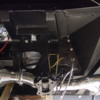Chris:
The headers are from P.I. Motorsports, and were selected by them as part of the 427 Windsor engine package they sent me. You can give Jerry Sackett a call there if you want more information: 1 (714) 744-1398
The problem I had with the headers is that the collector tapers down to a 2 ½” flange which in my (worthless) opinion, and in a number of other people’s opinions (that are worth something), is not large enough for a 540 hp stroker. We solved this by cutting the collector back until we could weld on a new 3” flange.
The mufflers were made by Mind-Train in Los Angeles, and I obtained them from Fred Matsumoto there but, as I recall, they were the last ones he had. They are a 12 inch "glass-pack" or bottle muffler with a 2 ¼” custom-made spiral louver core and a 3 ½” outer shell diameter. As I recall, Fred said they are made of something like aluminized steel (if that makes any sense).
The tips are 18 gage 3” diameter pipe. Fred does not have any more left so I had to have mine custom made from a flawed sample that he was good enough to send me. I still have it, and would be willing to pass it along if you need it. Fred has a specific recommended procedure for chroming the tips that minimizes heat discoloration. He suggests first polishing the steel, then nickel plating and only then chrome plating. Most importantly, he recommends against using any copper in the mix.
Fred also supplied me with the 2 ¼” resonators for insertion into the tips. They are meant to be a press fit, but we found that after the system heated up, the differential expansion of the tips caused the resonators to come loose. They would then shoot across the shop whenever we revved the engine. This was amusing for a while, but then we put some set screws into the bottom of the tips and put an end to that!
The crossover was custom made locally according to instructions from Fred.
I found Fred a pleasure to deal with, and if you have any more questions I would encourage you to give him a call directly: (323) 931-3732
With respect to the half-shafts, it is hard to get the proper camera angle to really see them – although the attached picture may do the trick. Regardless, I don’t think you need a photo to understand the concept. Simply unbolt each half shaft at both ends, rotate it 180 degrees, and bolt it back up! I read somewhere someone’s concern about water running into the sleeves after they flipped their half shafts. However, I am told by people who know more than I do that the sleeve is sealed sufficiently for this not to be a likely problem.
- Peter


